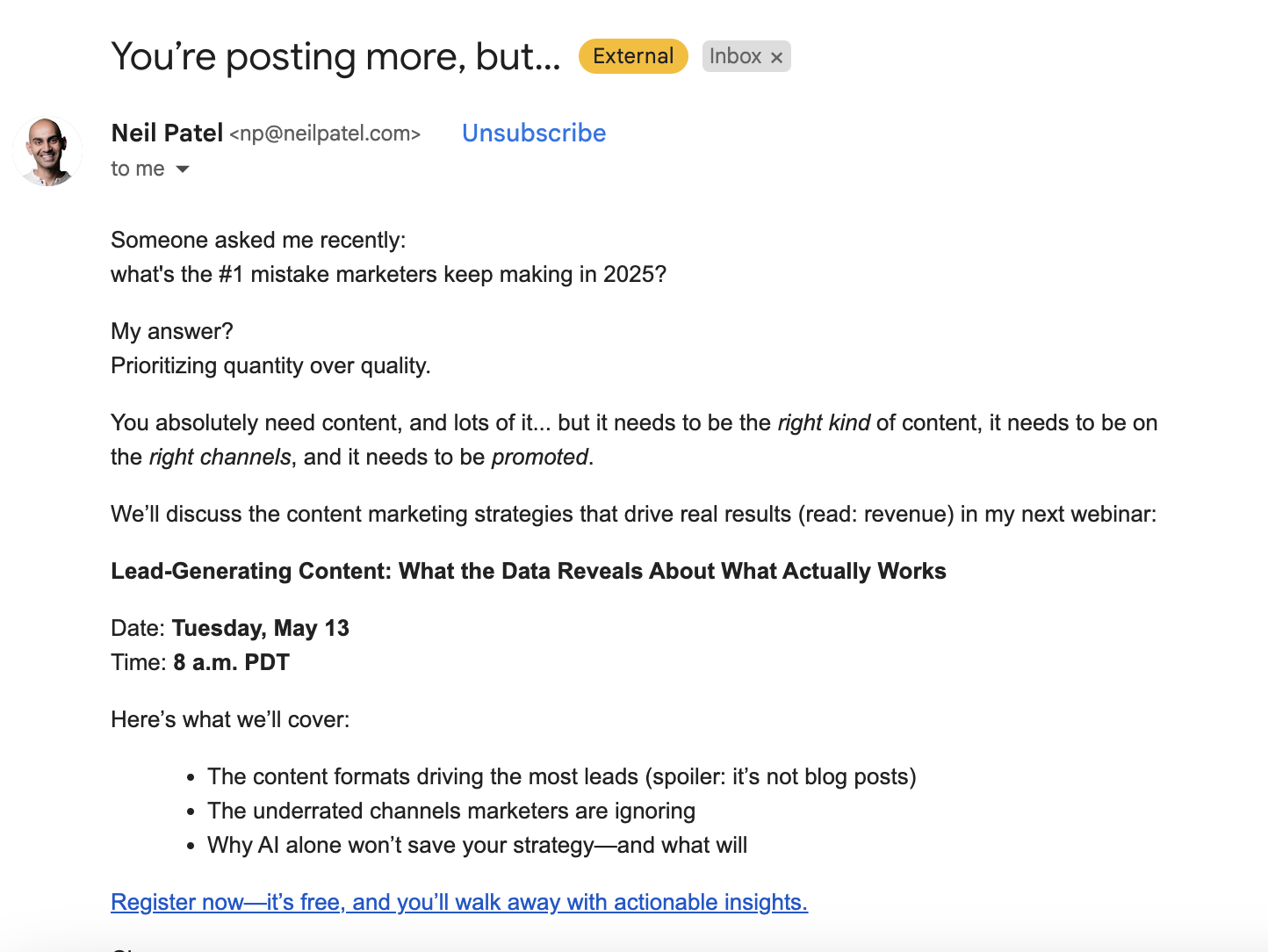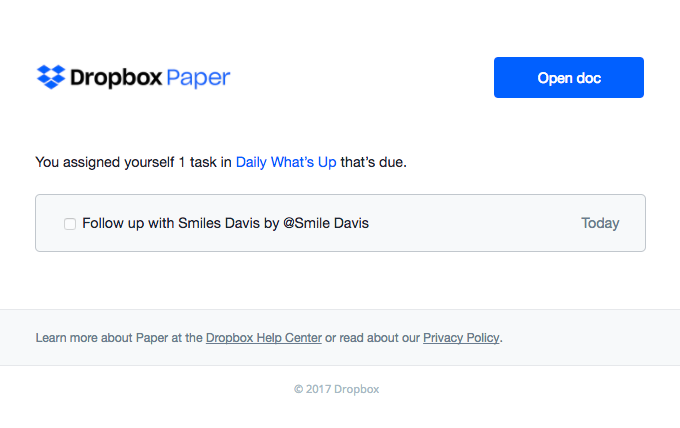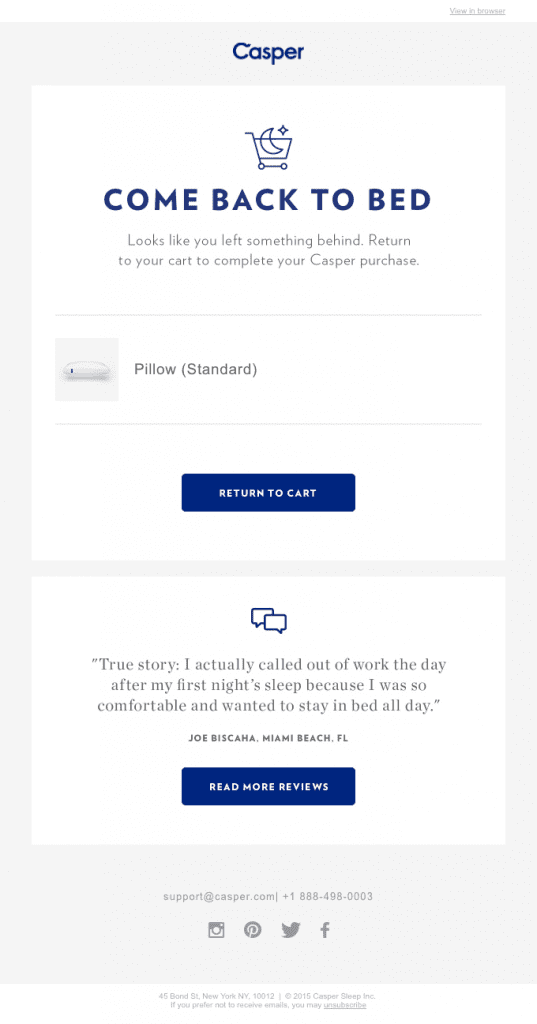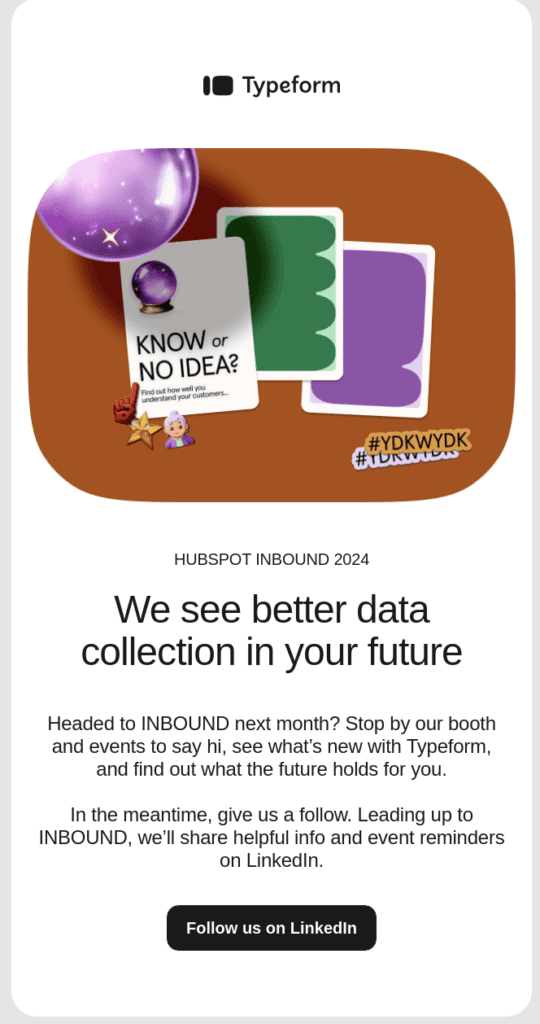- Blog
- 17 Different Types of Emails (With Email Marketing Examples You Can Steal)
17 Different Types of Emails (With Email Marketing Examples You Can Steal)
-
Nikolett Lorincz
- Marketing
- 6 min read
Table of Contents
Emails are one of the best ways to communicate directly with your audience—both prospective and existing customers. This direct link to your subscribers gives you a chance to offer a great promo code, remind customers about upcoming seasonal sales, or tell someone how much you appreciate their business in an anniversary email.
To make the most of your email strategy, it’s crucial to choose the right type of email for each message. In fact, the format you pick can be the difference between a successful campaign and one that falls flat.
That’s why we’ve put together this handy guide featuring the most important types of emails you can use to connect with your subscribers.
Let’s get right into it!
1. Plain-text email campaigns
Plain-text emails are exactly what they sound like: an email marketing campaign that’s written in plain black text on a white background.
Some audiences prefer getting straight to the point, and dislike anything that can be seen as “fluff” or “filler,” like unnecessary animations or too many pictures. Plus, a plain-text email seems more like a casual message between friends, rather than something a marketing team worked on for a long time.
When you’re writing a plain-text email, there’s no need to do any kind of fancy formatting. Just write what you want and send it out! It’s fine to add links, but avoid anything else.
Plain-text emails might help your email campaign land straight in the primary inbox (rather than Gmail’s promotions tab), which will skyrocket your open rate.
Here’s an example of a plain-text email:

2. Formatted marketing emails
Most marketing emails today use detailed formatting to stand out and make their point. This is true for both promotional emails and regular email campaigns like a weekly newsletter.
You can experiment with different options to get the best click-through rates. Colors, layouts, and many other elements can all make a crucial difference.
Just make sure the format fits the content of your email and doesn’t distract from key information. Remember that your end goal is to convince your subscribers to respond to your call to action, not get lost in an arcade of colors.
Here’s an example of a formatted email:

3. Welcome emails
A welcome email is your chance to make a great first impression on your new subscribers. Hopefully, it represents the beginning of a beautiful friendship!
This doesn’t mean you should try to pack as much as possible into your welcome email.
Instead, keep it simple and only add relevant content that fits into a welcome email.
You might choose to gather some of the questions you get asked most frequently, or give your recipient a few links so they know where to go for help. Or you could simply ask them how they’re doing and why they chose to subscribe—you can learn a lot, and you won’t take up more of their time than necessary.
The best way to think of welcome emails is as lead nurturing emails, which means you want to provoke interest in your future communications.

Source: Really Good Emails
4. Transactional emails
Unlike most other types of emails in this list that are meant for a wider audience, transactional emails are sent “one-to-one.” They usually contain important information that the customer expects to receive like order confirmations, receipts, and similar notifications.
These are usually standalone emails that aren’t part of a wider email marketing campaign, so you don’t need to go overboard with your marketing efforts. Instead, just deliver the necessary information.
For example, in an order confirmation email, you’ll want to include the standard info, a tracking link, and a warm thank you to your customer for their purchase.
5. Reminder emails
Reminders are one-to-one emails, just like transactional emails. Their goal is simple: to remind the recipient about something crucial. This can be an upcoming event, an unpaid invoice, or an unfinished payment.
Free trial expirations also fit into this category, and they’re important for SaaS companies. In this case, your goal is to get a customer to subscribe to your paid service.

Source: Really Good Emails
6. Newsletters
Newsletters are a collection of new information. Usually, they fit into one of the following types of emails:
- A digital newsletter with helpful advice about your products or educational resources for customers about the problem you’re solving
- An announcement email, highlighting upcoming events or sales
- A newsletter presenting new key features of your site or platform, plus online reviews of your upgrades
- A promotional email with a special offer or other incentives for future purchases
Your email marketing newsletters should always offer valuable content that rewards your subscribers for opening them. If you don’t accomplish this, not only will your email campaigns fail to drive blog traffic or increase sales—they won’t even be opened.
You should make sure that your call to action is clear and noticeable. Too much information will distract from your CTA and lead to lower open rates and click-through rates. Keep it short and interesting!
7. Announcement emails
In an announcement email, you’re announcing something so vital that it’s worth sending in a standalone marketing email.
For instance, you might send out an announcement email when you’re launching a crowdfunding campaign or announcing a brand new product.
In these emails, the key information should be clear from your subject line: you want your subscribers to know what the email is about.
8. Promotional emails
Promotional emails are one of the most popular types of emails for ecommerce stores.
They can encompass upcoming seasonal sales, including announcements about discounts, special offers, early access, and exclusive content. Ideally, they both inform and excite your customers.
Since they’re so common, your subscribers will likely get dozens of promotional emails from different brands every single day, so it’s important to get creative with these kinds of emails to stand out from the crowd.
9. Job offers
Hiring is easiest when you target people who are already following you.
If you have a hard time finding new team members, sharing the job offer with your subscribers is usually a good idea. Even if they don’t apply themselves, they might recommend someone who will!

10. Lead nurturing emails
Lead nurturing emails fit into your sales funnel by deepening the brand-customer relationship and finally converting your subscribers into customers. You can accomplish this by setting up email sequences based on a customer’s past behavior.
For example, if you send out emails to developers who are just getting started, you can check who clicked on articles about JavaScript in your past newsletters. Then, begin promoting your new “JavaScript for beginners” course only to them.
It’s important that you gather enough data about a new subscriber so you’ll be able to target them with the right kind of lead nurturing emails.
11. Feedback request emails
Not all automated email sequences need to end in a purchase.
Sometimes, gathering honest feedback from your customers is one of the most valuable results you can gain from an email campaign!
When a customer offers helpful advice, you can use it to improve your product and/or your email marketing strategy. You can also use five-star reviews collected from a loyal existing customer to improve your ratings on platforms like Google or Facebook with a review request email.

12. Milestone emails
Reward your most loyal customers with milestone emails that celebrate their progress—like hitting a points threshold or unlocking a new loyalty tier.
These emails drive engagement and reinforce customer loyalty.
What to include:
- The milestone achieved
- Rewards earned or next steps
- A celebratory message or badge
13. Anniversary emails
Who doesn’t love a little appreciation? Anniversary emails are a simple way to show customers you value them—whether it’s their signup date or birthday.
Add a coupon, a freebie, or just a heartfelt thank you to make it special.
14. Abandoned cart emails
Every ecommerce brand knows the heartbreak of the abandoned cart. A customer browses your site, falls in love with a product, adds it to their cart… and then disappears.
That’s where abandoned cart emails come in. These emails act as a gentle nudge, reminding the shopper of what they left behind—and giving them a reason to come back.
What makes them so effective is their timing and relevance. They’re triggered automatically, often within a few hours of the cart being abandoned, while the product is still fresh in the customer’s mind.
The best abandoned cart emails don’t just remind people of what they almost bought—they reignite interest by adding value. Maybe it’s a photo of the item, a quick product benefit, or even a cheeky line that says, “Forget something?”
Some brands offer a small discount or free shipping to close the deal, while others simply use urgency (“Your cart will expire soon”) to push action. Either way, these emails routinely deliver some of the highest ROI in email marketing—because the intent to buy is already there.

15. Event emails
Whether it’s a webinar, product launch, live demo, or in-person meetup, event promo emails are your go-to for generating interest and filling seats.
They’re especially powerful when used as a short sequence—like a teaser email, a formal invite, and then a last-chance reminder.
How to do it right:
- Lead with the value: what will attendees learn or gain?
- Make registration frictionless with a clear CTA.
- Use countdowns and reminders as the event date approaches.

16. Cross-sell emails
Cross-sell emails are all about helping customers discover more—not pushing random products.
These emails show related or complementary items based on what a customer just bought or browsed. Think of it like the “You might also like…” section in your inbox.
For example, if someone just bought a DSLR camera, offer them a memory card, a lens, or a carrying case.
Here’s how to make them work:
- Base suggestions on real purchase data or browsing behavior.
- Keep the number of recommendations low (3–5 max).
- Personalize the subject line for a higher open rate.
17. Confirmation emails
Confirmation emails are transactional in nature, but they deserve their own spotlight because they build trust.
These are sent after someone makes a purchase, registers for a webinar, subscribes to a list, or books a service. Basically, it’s your digital way of saying, “Got it!”
FAQ
How many types of marketing emails should a business use?
There’s no one-size-fits-all number, but most businesses benefit from using a mix of at least 5–7 core email types, including welcome, promotional, newsletters, and transactional emails. As your strategy matures, layering in more targeted emails like lead nurturing or milestone emails can supercharge engagement.
What’s the difference between promotional emails and transactional emails?
Promotional emails are designed to drive action—like making a purchase, using a discount, or signing up for an event. Transactional emails, on the other hand, are triggered by a user’s action, like a purchase confirmation or password reset. One sells; the other informs.
How do I know which email type to send?
Start by identifying your goal:
- Want to build trust? → Try welcome or feedback emails.
- Looking to drive sales? → Use promotional or cart abandonment emails.
- Hosting an event? → Send a well-timed event invite sequence.
Map your email type to your objective and audience behavior.
What type of email is best for re-engaging inactive subscribers?
Cart abandonment emails, reminder emails, and lead nurturing sequences work wonders for re-engagement. Add value, address friction points, and offer a compelling reason to come back—like a special discount or exclusive content.
Wrapping up
Email marketing isn’t just about writing good copy—it’s about sending the right kind of message, at the right time, to the right person.
From welcome emails to reminders, job offers to product promos, each email type plays a role in building your brand and boosting your bottom line.
Master these 17 types, and you’ll be well on your way to becoming an inbox MVP.
Migration has never been easier
We made switching a no-brainer with our free, white-glove onboarding service so you can get started in the blink of an eye.

What should you do next?
Thanks for reading till the end. Here are 4 ways we can help you grow your business:
Boost conversions with proven use cases
Explore our Use Case Library, filled with actionable personalization examples and step-by-step guides to unlock your website's full potential. Check out Use Case Library
Create a free OptiMonk account
Create a free OptiMonk account and easily get started with popups and conversion rate optimization. Get OptiMonk free
Get advice from a CRO expert
Schedule a personalized discovery call with one of our experts to explore how OptiMonk can help you grow your business. Book a demo
Join our weekly newsletter
Real CRO insights & marketing tips. No fluff. Straight to your inbox. Subscribe now
Nikolett Lorincz
- Posted in
- Marketing
Partner with us
- © OptiMonk. All rights reserved!
- Terms of Use
- Privacy Policy
- Cookie Policy
Product updates: January Release 2025








